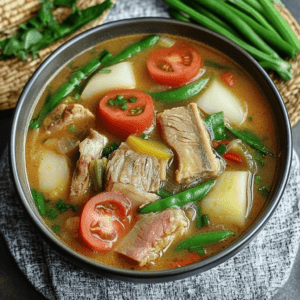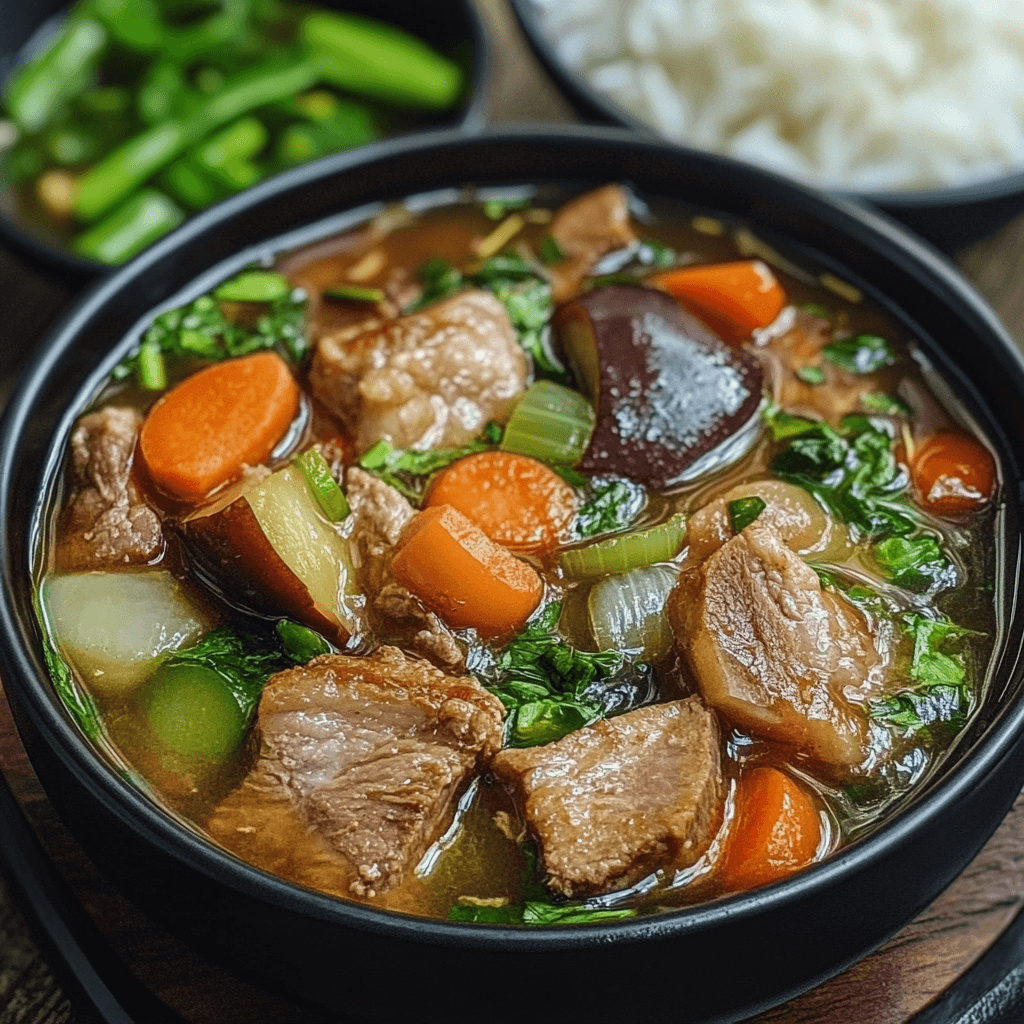Sinigang is a beloved Filipino soup celebrated for its tangy and savory flavors, made using the main ingredients of Sinigang such as fresh protein, a variety of vegetables, and a souring agent like tamarind. This combination creates a comforting dish that is both versatile and nutritious.
The Origin of Sinigang
The origins of Sinigang are deeply rooted in Filipino history. While the dish’s exact beginnings are debated, its name is derived from the Tagalog word “sigang,” which means “to stew.” Over the centuries, it has become synonymous with home cooking, a dish passed down through generations, symbolizing love, comfort, and tradition.
Cultural Significance in Filipino Cuisine
Sinigang embodies the Philippines’ agricultural abundance, showcasing fresh, locally sourced ingredients. It’s often served during family meals, celebrations, and rainy days, making it a comfort food loved by many.
Key Characteristics of Sinigang
Sinigang is more than just a soup; it’s a sensory experience. The defining characteristic is its sour broth, which awakens the palate. Let’s explore the essential elements that make Sinigang unique.
Distinct Sour Flavor
The sourness of Sinigang is its most notable trait. The tangy flavor, primarily from tamarind, is what sets it apart from other soups. This sourness isn’t overpowering—it’s a harmonious balance that complements the savory components.
Versatility of Ingredients
Sinigang is incredibly versatile. While the classic version features pork, the recipe can be adapted to use other proteins, vegetables, and even souring agents, making it accessible and customizable.
Nutritional Benefits
Sinigang is packed with nutrients, thanks to its combination of fresh vegetables, lean proteins, and a flavorful yet light broth. It’s a wholesome dish that can be enjoyed as part of a balanced diet.
The Main Ingredients of Sinigang
The main ingredients of Sinigang are simple yet essential to achieving the dish’s iconic flavor. From fresh proteins to nutrient-packed vegetables, each component plays a vital role in the soup’s taste and texture.
Protein Options in the Main Ingredients of Sinigang
The choice of protein is one of the main ingredients of Sinigang. While pork is traditional, other options like beef, shrimp, and fish are also common. These proteins provide richness and complement the sourness of the dish.
Vegetables in the Main Ingredients of Sinigang
Vegetables are integral to the main ingredients of Sinigang, adding flavor, texture, and nutrition. Common options include radish, eggplant, okra, and kangkong (water spinach). These ingredients create a balanced and hearty meal.
Alternatives
- Beef: Often used for a more robust flavor.
- Chicken: A lighter option, perfect for a less fatty broth.
- Seafood: Shrimp and milkfish (bangus) bring a fresh, oceanic twist to Sinigang.
- Vegetarian Proteins: Tofu or mushrooms are excellent substitutes for a plant-based version.
The Role of Tamarind (Sampalok)
Tamarind is the heart of Sinigang, providing the sourness that defines the dish.
How Tamarind Defines Sinigang
Tamarind pulp or tamarind-based powders are simmered into the broth, releasing a tangy essence that melds with the other ingredients.
Souring Agent Alternatives
If tamarind isn’t available, home cooks often use alternatives like:
- Calamansi juice
- Green mangoes
- Sinigang mix (a convenient store-bought option)
Vegetable Additions
Sinigang is a vegetable lover’s delight, incorporating a variety of produce that adds flavor, texture, and nutrients.
Traditional Vegetables
- Radish (Labanos): Adds a subtle sweetness and crunch.
- Eggplant: Absorbs the sour broth beautifully.
- Okra: Adds a slight thickness to the soup.
- Kangkong (Water Spinach): Provides freshness and leafy texture.
Variations
Other vegetables like spinach, string beans, or even tomatoes can be added for a unique twist while maintaining the dish’s integrity.
Broth Base
The broth is the soul of Sinigang, created with care to enhance every ingredient.
Importance of a Well-Prepared Broth
A rich and flavorful broth sets the stage for the dish. Using bones or a protein base enhances depth.
Homemade vs. Store-Bought
While homemade broth is ideal, using store-bought alternatives can save time without sacrificing too much flavor.
Spices and Seasonings
The simplicity of Sinigang lies in its minimal yet effective use of seasonings.
Common Seasonings
- Salt and Pepper: For basic seasoning.
- Fish Sauce (Patis): Adds a distinct umami flavor.
- Onions and Tomatoes: Provide sweetness and enhance the broth’s complexity.
Enhancing the Flavor
Subtle additions like garlic or ginger can elevate the dish, making it uniquely yours.
Cooking Techniques for Sinigang
Preparation methods vary, but the goal remains the same: a comforting, flavorful dish.
Traditional Stovetop Method
Sinigang is traditionally cooked on a stovetop, simmering the ingredients until tender and well-blended.
Pressure Cooker and Slow Cooker Methods
Modern tools like pressure cookers and slow cookers can save time while ensuring a deeply flavored broth.
Regional Variations of Sinigang
Different regions in the Philippines have their own take on Sinigang, showcasing local ingredients and culinary traditions.
- Luzon: Focuses on pork Sinigang with tamarind.
- Visayas: Often uses seafood due to proximity to the sea.
- Mindanao: Incorporates unique vegetables and spices for a bolder flavor.
Pairing Sinigang with Rice and Side Dishes
Sinigang is rarely eaten alone; it’s complemented by other dishes.
Rice as a Staple
Plain white rice is the perfect partner for Sinigang, balancing its sourness and absorbing the flavorful broth.
Popular Side Dishes
- Fried fish or dried fish.
- Sauteed vegetables like gising-gising.
- Pickled side dishes for an additional tangy element.
Health Benefits of Sinigang
Sinigang is more than just delicious; it’s also nutritious.
Nutritional Value
Rich in vitamins from vegetables and protein from the meat, Sinigang is a well-rounded meal.
Balanced Diet
The light, broth-based nature of Sinigang makes it an excellent choice for those who are mindful of their calorie intake. Packed with fresh vegetables and lean proteins, the dish offers a nutrient-rich meal that is both satisfying and low in calories. The tangy broth is flavorful without the need for heavy creams or oils, making it a wholesome option for individuals seeking a lighter yet hearty dish. Its versatility also allows for adjustments, such as using fish or chicken instead of fattier meats, further enhancing its suitability for health-conscious diners.
Common Mistakes in Making Sinigang
Even experienced cooks can face challenges when preparing Sinigang, as achieving the perfect balance of flavors and textures requires attention to detail. Common pitfalls include overusing the souring agent, resulting in an overly sharp broth, or overcooking the vegetables, which can lead to a mushy texture that detracts from the dish’s appeal. Adding too much fish sauce or salt can also overwhelm the delicate flavors of the other ingredients. However, by carefully monitoring seasoning, cooking times, and ingredient proportions, even seasoned cooks can overcome these hurdles and create a Sinigang that is both delicious and satisfying.
Over-Souring the Broth
Using too much souring agent in Sinigang can overwhelm the dish, masking the natural flavors of the meat and vegetables and making the broth overly sharp. Achieving the right balance is essential to creating a harmonious and enjoyable dish. Start with a moderate amount of your chosen souring agent, such as tamarind, calamansi, or green mango, and adjust gradually by tasting the broth as you go. The goal is to achieve a tanginess that complements the savory and fresh elements without dominating them, ensuring that every spoonful is well-rounded and flavorful. Balance is key to perfecting this beloved classic.
Overcooking Vegetables
Overcooking vegetables in Sinigang can lead to a soft, mushy texture that detracts from the dish’s overall appeal. The vibrant crunch and freshness of the vegetables are an essential part of what makes Sinigang so enjoyable. To preserve their texture, it’s important to monitor cooking times carefully and add the vegetables in stages based on their firmness. Firmer vegetables like radish and string beans should go in earlier, while tender greens like kangkong or bok choy are best added just before serving. This ensures that every bite offers a delightful combination of tender meat, tangy broth, and perfectly cooked vegetables.
Misbalancing Flavors
Using too much fish sauce or salt in Sinigang can easily overpower the delicate balance of flavors and mask the natural taste of the other ingredients. While these seasonings are essential for enhancing the savory depth of the dish, it’s important to add them gradually and taste as you go. Overuse can result in a dish that is overly salty, diminishing the tangy brightness of the broth and the freshness of the vegetables. By seasoning with care, you can achieve a harmonious flavor profile that allows each ingredient to shine, creating a more satisfying and well-rounded Sinigang.
Tips for Perfecting Sinigang
Achieving the Ideal Sourness
When preparing Sinigang, it’s best to start with a smaller amount of souring agent, such as tamarind paste or calamansi juice, and adjust gradually to achieve your desired level of tanginess. This approach allows you to control the flavor balance and avoid overpowering the dish with excessive sourness. By tasting the broth as you go and adding more souring agent in small increments, you can ensure a perfectly balanced flavor that complements the other ingredients. This careful adjustment makes the dish more enjoyable for everyone, catering to individual preferences for the signature tangy taste of Sinigang.
Maintaining Texture
Adding vegetables in stages during cooking is key to ensuring each one is cooked to perfection and retains its unique texture and flavor. By introducing firmer vegetables like radish and carrots earlier in the cooking process, you allow them enough time to soften and absorb the savory, tangy broth. More delicate vegetables, such as kangkong (water spinach) or okra, should be added later to prevent them from becoming overcooked or mushy. This method not only enhances the overall presentation of the dish but also ensures that every bite offers the perfect balance of tenderness and freshness, making your Sinigang truly enjoyable.
Enhancing the Broth
Letting the broth simmer for an extended period significantly enhances its flavor, allowing the ingredients to fully release their essence into the dish. The slow cooking process melds the tangy tamarind base with the savory notes of the meat and vegetables, creating a rich and harmonious taste profile. This technique not only deepens the overall flavor but also ensures that the broth develops a velvety texture, making each spoonful more satisfying. Taking the time to let the Sinigang simmer is a simple yet effective way to elevate this classic dish to its fullest potential.
Sinigang for Special Occasions
Although Sinigang is often enjoyed as a daily staple in many Filipino households, it also shines as a crowd-pleaser during gatherings and special events. Its comforting, tangy broth and hearty ingredients appeal to a wide range of tastes, making it a versatile dish that effortlessly brings people together. Whether served at a casual family dinner or a festive celebration, Sinigang’s rich flavors and satisfying warmth make it a favorite choice for creating memorable meals and shared experiences. Its ability to adapt to different preferences and occasions further cements its place as a beloved classic in Filipino cuisine.
Festival Adaptations
For special occasions and celebrations, some families elevate their Sinigang by incorporating premium ingredients such as succulent prawns or high-quality cuts of beef. These additions not only enhance the dish’s flavor but also make it feel more luxurious and festive. Prawns bring a delightful sweetness and a touch of elegance to the tangy broth, while tender, premium beef adds a rich, hearty depth that elevates the entire meal. These thoughtful variations reflect the significance of the occasion, transforming the traditional dish into a centerpiece of joy and togetherness for family gatherings.
Creative Twists
Infusions such as coconut milk or chili can transform Sinigang into exciting fusion variations, bringing a new and innovative twist to this beloved traditional Filipino dish. By incorporating creamy coconut milk, the dish takes on a richer, velvety texture that beautifully complements the tangy tamarind base, creating a delightful balance of flavors. Meanwhile, the addition of chili introduces a spicy kick that enhances the depth of the broth, making it even more dynamic and bold. These creative adaptations showcase how versatile Sinigang can be, offering a fresh perspective on a classic recipe while maintaining its comforting and heartwarming essence.

Frequently Asked Questions
What makes Sinigang different from other soups?
The unique sourness from tamarind sets it apart.
Can Sinigang be made vegetarian?
Yes, tofu and mushrooms can replace meat.
What is the best meat for Sinigang?
Pork ribs and belly are classic, but shrimp and fish are also popular.
How can I store leftover Sinigang?
Store in an airtight container and refrigerate for up to 3 days.
Is it possible to make Sinigang less sour?
Adjust the tamarind or add more water to balance the flavor.
What are the alternatives to tamarind in Sinigang?
Calamansi juice, green mango, or store-bought Sinigang mix can be used.
Conclusion
The main ingredients of Sinigang come together to create a dish that is not only flavorful but also a true reflection of Filipino culture. Whether prepared traditionally or with modern twists, these ingredients make Sinigang a cherished meal in households around the world.
Related article:
10 Reasons Why Filipino Sinigang is Healthy: Boost Your Wellness
The Ultimate Guide to Sinigang Recipe: A Timeless Filipino Classic

